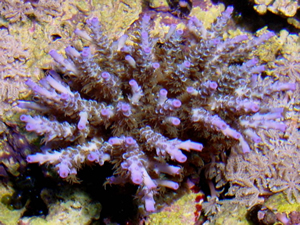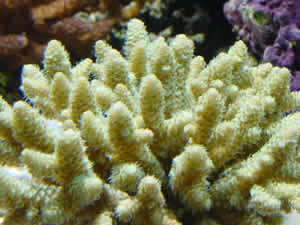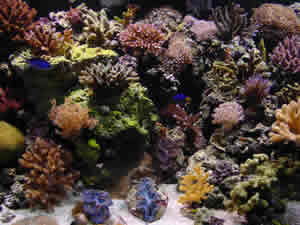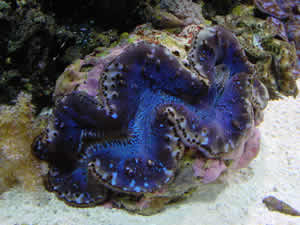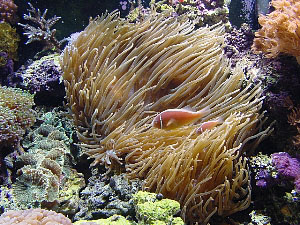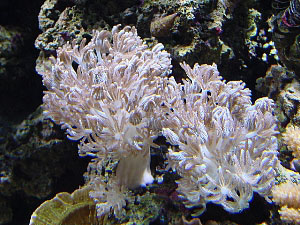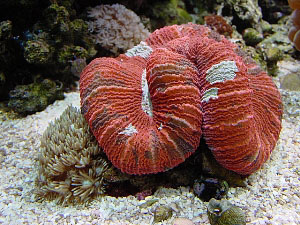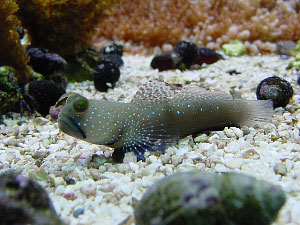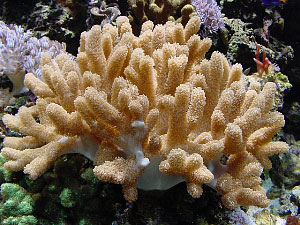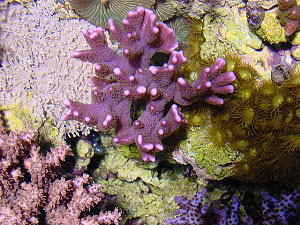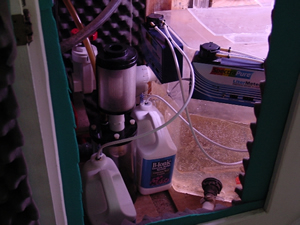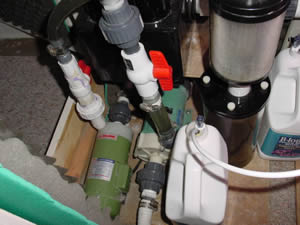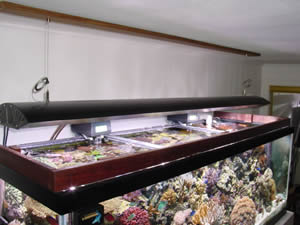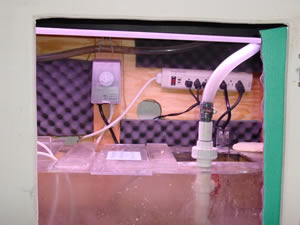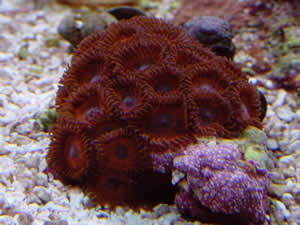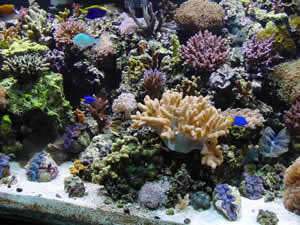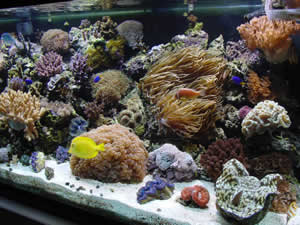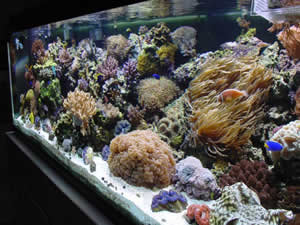Kedd Lyttonsmith’s Reef Tank

Background:
My love of the ocean and aquariums goes
back as far as I can remember. I grew up in the sportfishing
industry and my first saltwater tank was stocked with fish
caught off the coast of Baja, Mexico. The water I used was
filtered seawater drawn straight from the Pacific at Scripps
Institute of Oceanography. The tank had everything from
small White Sea Bass (oops) to a two inch long Yellowtail
that had been caught with bait rigs on the kelp paddies
offshore. It was a great local tank, and was lots of fun
during feeding time! I relocated to the East Coast about
five years ago, leaving my tank behind. I didn’t anticipate
starting another tank, let alone a reef tank, until I was
captivated by the outstanding tanks at Reef and Fin in Stamford,
CT. At that point I knew I had to have another tank, and
with the help of the shop’s owner, Chris Jessen, I
took my hobby to a new level. Piece-by-piece, I got my hands
on all the equipment I really wanted to act as the foundation
of this 180-gallon aquarium. With alot of trial and error,
some much needed advice, and my wife looking the other way
at the checkout counter, it has become the reef tank I am
sharing with you today.
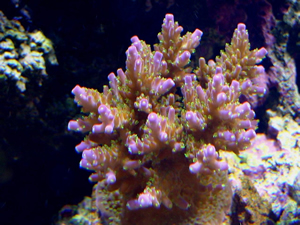 |
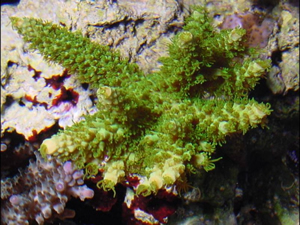 |
|
Aquarium Profile
• |
180 gallon AGA
aquarium with a 65 gallon refugium/sump |
• |
Dimensions: 72"L x 24"H
x 24"W |
• |
DIY stand – 76”L
x 28”W x 43”H |
• |
Stand and tank combined height
5’9” |
|
Design:
The tank is set up against the
main wall of my family room, making it the center of attention.
Three sides are viewable, while the back is painted black.
Each corner contains an overflow. The lighting is a pendant
design that hangs from the ceiling.
The stand is built out of 2 x 4’s spaced every 16
inches with ¾ inch marine plywood used for the top
and sides. It is trimmed with 1 x 4’s with two large
access doors in the front, and one on the left side. The
side door gives me easy access to the pumps and skimmer,
and allows me to slide the sump out the side, if I remove
the skimmer. It is ventilated with two 4” fans which
provides cooling for the pumps and the skimmer. I have added
egg crate acoustic foam on the interior of the stand to
aid in soundproofing the equipment since the Iwaki and the
Mak4 pumps would be too loud for the family room area. The
stand is equipped with lighting for the 65-gallon sump and
built to incorporate everything needed to operate the aquarium,
with the exception of the chiller. The finish on the stand,
an Interlux marine epoxy used for wooden boats, has held
up unbelievably well over the past four years.
For long power outages, I am lucky enough
to have a small gas generator (not hooked up to the tank
unless needed) that will run all pumps in the tank. The
tank and all components are on their own separate breaker
box from the rest of the house, so if the house trips a
circuit, the tank will keep running. The tank is on three
20amp breakers with the lighting, chiller and pumps all
having their own separate circuit. The breaker box for the
tank also has lightning protection; the fuse will blow,
but the components are 99.9% safe.
|
Lighting
Profile
|
• |
6’ pendant style fixture
(AB Aquaspacelight) w/two timers – actinics
& halides on separate timers |
|
• |
3 x 250W 10,000K HQI (Ushio bulbs) on a 9-hour
photoperiod |
|
• |
4 x 24W PC Actinic on a 12-hour photoperiod |
|
• |
2 x 65W Smartlights on a reverse 12 hour daylight
schedule for the sump |
|
• |
Bulb height from water surface is 8 inches |
|
|
Circulation Profile
|
• |
Circulation was originally provided
by powerheads, but it has since changed to a closed-loop
system with no powerheads |
|
• |
Skimmer pump is an Iwaki MD 55RLT |
|
• |
Return pump is a GenX MAK-4 (one ¾”
return in each corner) |
|
• |
Closed-loop pump is a CustomSeaLife velocity
T-4 |
|
• |
Two returns on the closed-loop system are oscillated
by Sea Swirls |
|
• |
Chiller is incorporated into the closed-loop
system |
|
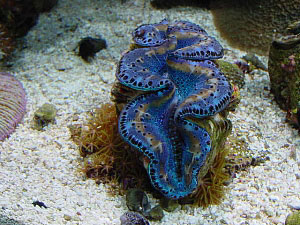 |
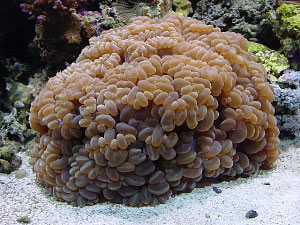 |
The tank is now four years old
and many of the corals and fish in the tank have been with
me since the beginning. Almost all of my corals and fish
have come from my local fish store in Stamford. I have also
traded with a few of the members of Reef Central and have
received some very nice SPS frags. One of the biggest enjoyments
I get from the tank is in witnessing the growth of the corals.
I find watching a small fragment of a brown coral as it
attaches itself to the rock, and then slowly changes color
to a bright purple, blue, pink or some other color, to be
truly incredible.
Pic#11 Pic#12
|
Filtration Profile
|
• |
200lbs. of Fiji live rock |
|
• |
5-6” DSB (aragonite) |
|
• |
65 gallon sump (1/4 of which is sectioned-off
as a refugium using caulerpa as a nutrient export) |
|
• |
ETSS® 800 skimmer |
|
• |
ESV activated carbon |
|
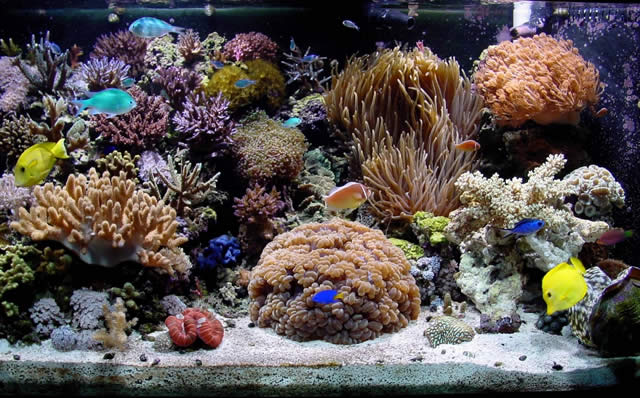
Maintenance:
My regularly scheduled maintenance
consists of cleaning the skimmer two times a week and cleaning
the glass 3 times a week with algae magnets. There are certainly
unexpected chores that pop up occasionally, but the basic
maintenance of the tank’s hardware does not require
more than about two hours per week. Water tests are done
weekly, consisting of measuring alkalinity, calcium, pH,
and magnesium. A water change of 15 gallons is performed
every two weeks. Unfortunately, water top-offs have to be
done manually on this tank due to the fact that it is not
located close enough to an area where an automatic top-off
system can be easily installed. RO/DI is used exclusively
and the evaporation rate in the tank is 2.5 gallons per
day. As might be imagined, making sure that I have enough
top-off water on hand is a constant concern.
|
Water Parameters
|
• |
Ca: 425-450 (Salifert) |
|
• |
dKH: 10-11 (Salifert) |
|
• |
pH: 8.1 – 8.3 (PinPoint Monitor) |
|
• |
Mg: 1350 ppm (Salifert) |
|
• |
Phosphate: 0 |
|
• |
Nitrate: 0 |
|
• |
Specific Gravity: 1.026 |
|
Most of the additives I use are
ESV products and consist of calcium, alkalinity, magnesium,
strontium and iodide. I also add trace elements once a week
using CombiSan™. All of the additives are used at
the manufacturer’s recommended amounts.
Feeding:
Feeding is performed once a day
in the evening, and consists of a combination of frozen
Mysis shrimp, silversides, brine shrimp, and veggies (Sea
Veggies™, Tenera Blue and spinach). I feed dry food,
a mixture of pellets and flake, every other morning. The
corals and clams are given Tahitian Blend™ (frozen
phytoplankton) three times a week.
The only target feeding I have to do is for the seahorse.
The seahorse is not captive-bred and had to be weaned from
the live brine to the frozen ones. He has adapted well to
the change and actually seems to ‘come to dinner’
during feeding time, always positioning himself in the same
area to receive his food.
|
Temperature Control
• CustomSeaLife
1/3hp chiller
• RenaCal 300 watt heater
|
|
Inhabitants:
|
SPS* |
|
Acropora abrolhosensis |
Acropora microclados |
Pocillopora damicornis |
|
Acropora divaricata |
Acropora millepora (green) |
Porites
divaricata |
|
Acropora humilis (lime green) |
Acropora sqarrosa |
Seriatopora hystrix |
|
Acropora hyacinthus |
Hydnophora pilosa |
Stylophora subseriata |
|
Acropora loisetteae |
Montipora digitata
(pink, purple, red) |
|
| Clams |
|
1 Tridacna crocea |
4 Tridacna maxima |
1 Tridacna derasa |
|
LPS* |
|
Caulastrea furcata |
Euphyllia divisa |
Euphyllia paradivisa |
|
Fungia repanda |
Plerogyra sinuosa |
Trachyphyllia geoffroyi |
| Soft Corals* |
| Capnella |
Lemnalia |
Sinularia |
| Assorted Discosoma |
|
Xenia (white Pom Pom) |
|
Fish |
|
1 Shoal Tang |
1 Yellow Tang |
6 Green Chromis |
|
1 Sixline Wrasse |
1 Flame Hawk |
1 Chalk Bass |
|
3 Pink Skunk Clown
fish |
1 Swallowtail Angel |
1 Yellow Watchman
Goby |
|
1 Mandarin Goby |
2 Blue Reef Chromis |
3 Blue Damsels |
|
1 Signal Goby |
1 Seahorse |
1 Flasher wrasse |
| Inverts |
| Blue leg hermits |
Astrea snails |
Peppermint shrimp |
| Cleaner shrimp |
Harlequin shrimp |
Anemone (Heteractis
magnifica) |
I surf through Reef Central on
a regular basis and I am always amazed by the beautiful
tanks and am always grateful for the tips and advise that
the forums offer me. I hadn’t expected my hobby to
turn into such an obsession, but since it has, it’s
great that my reef tank is considered to be nice enough
to be in the same category as the other outstanding tanks
that have preceded mine as tank of the month…. What
a compliment!
Please feel free to post any questions
or comments in the discussion forum on Reef Central.
*Note: all corals are believed to be these species.

If there are questions, I will do my
best to answer them in the forum
for the online magazine.
|






